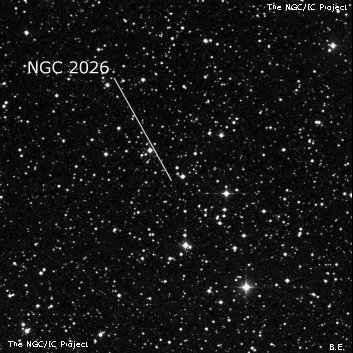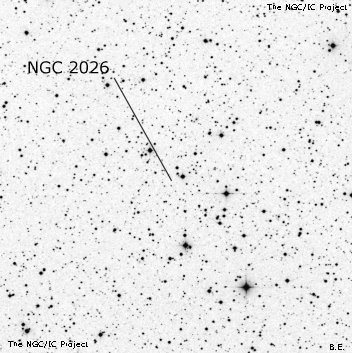NGC/IC Project Restoration Effort
(This is a very very beta version)
NGC2026


Basic Information
Location and Magnitude
Right Ascension: 5:43:12.0
Declination: +20:8:0
Constellation: TAU
Visual Magnitude:
Historic Information
Discoverer: Herschel W.
Year of discovery: 1784
Discovery aperture: 18.7
Observational
Summary description: Cl, lRi, lC, st pL
Sub-type: OCL
Corwin's Notes
=====
NGC 2026. WH's position, reduced by me using the Hipparcos position for the
nominal comparison star (54 Ori), is 36 seconds of time preceding the NGC
position. The NGC position is more nearly correct -- so where does it come
from? Not Auwers; his reduction agrees precisely with my reduction with the
Hipparcos data.
The answer is in CH's fair copy of WH's sweeps. There, in Sweep 329 on 5 Dec
1784, the offset from 54 Ori is given as 11m 19s preceding, 15 arcmin south.
The offset published in PT from which I and Auwers worked reads 11m 53s
preceding the star, and again 15 arcmin south. The difference, 34 seconds of
time with a minus sign, corresponds to a notation made in the log book just
below the recorded time of the observation of the star, not the cluster. The
same minus 34 seconds is noted for the next star in the Sweep, 62 Ori, and for
one star preceding, 102 Tauri, as well (two other stars, 105 and 106 Tauri,
have notations of "-12"). Yet the cluster was "moved" 34 seconds further away
from the star for its offset in the big PT paper. It's clear that this is the
source of the error. Now we have only to work out why WH applied the
"correction".
Toward that goal, I have been looking through CH's fair copy. I found this
comment following the short sweep 350 on 21 December 1784:
It appears now plainly that my late improvements in RA and PD have so far
succeeded that I now should use the places of the stars reduced to the
present time; but having registered all my Sweeps in the time and PD of
Flamsteed, I shall use them both till I may have leisure to alter my
register of Sweeps. The greatest inaccuracy now remaining in owing to the
clock not having a compound pendulum, but I shall endevour also to keep an
account of its errors, which I have found have formerly been very
considerable.
His comment "alter the register" may well be relevant. CH began her reduction
of WH's positions in 1799 and used not just Flamsteed's, Mayer's, and
La Caille's stars, but those in recently published catalogues by Wollaston and
Bode. Thus, the positions and reductions were worked over after they had been
published. And it was these newer reductions that were adopted by JH for his
working lists, the GC, and ultimately for the NGC.
WH mentions the clock, too, with its "very considerable" errors. I suspect
that the 34 second discrepancy comes from this source, though am still puzzled
by the fact that he included the 34 second difference in the published offset
for NGC 2026. I would have guessed that this came to light during CH's much
later reduction of the positions.
What is clear is that WH, just over a year into his systematic sweeps with the
20-foot telescope, was still experimenting and adjusting his observing
procedures. Not only did CH's post-publication reduction of the positions
take into account new star positions not available at the time of observation,
but WH himself was still learning the best way to conduct his sweeps and
gather his data.
Steve's Notes
=====
NGC 2026
17.5" (2/14/99): At 220x, ~30 stars in a 6' region including three mag 9-9.5 stars (mag 8.7 SAO 77440 and mag 9.3 SAO 77448). Most of the stars are mag 11-13. The group lacks any concentration and appears to be an asterism with the three brighter stars drawing attention to the group. However, there is a small arc of a half a dozen mag 13 stars that includes SAO 77448 at the SE corner and a nice clump of mag 13 stars is just south of the mag 9.5 star at the north end of the group. Listed as nonexistent in the RNGC.



